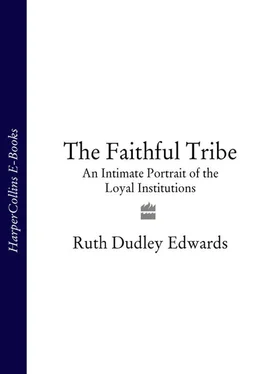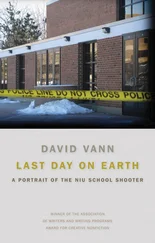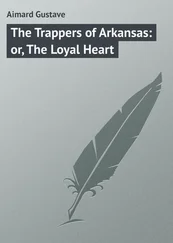To pre-empt trouble, on Wednesday the Secretary of State had banned the parade from the contentious part of the walls and had moved troops in to seal them off. In a particularly surreal contribution, a Bogside resident was quoted the following day in An Phoblacht/Republican News. ‘Why are they creating a screened walkway? … The suspicion is that they are to be used to allow the march to go ahead outside the view of residents.’
When I met the gentle and courteous Alistair Simpson on the Friday, he was still depressed by the last meeting he had had with MacNiallais and the insults he had had to endure and he was apprehensive about the build-up of frustration among the Apprentice Boys, but he was confident he would find a way to avert violence.
Friday afternoon was enlivened by seeing in action in front of the Guildhall the legendary Mary Nelis, Sinn Féin councillor and mother of MacNiallais, dubbed by a unionist colleague ‘the republican movement’s answer to Winnie Mandela’. * Less diplomatic than her son, she had recently observed in a speech that the Apprentice Boys should know that those whom she represented had ‘never conceded your right to exist’. Mrs Nelis enjoys drama (she is notorious among journalists for the frequency with which, in front of television cameras during nationalist protests, she appears to faint under the feet of RUC men). She was holding forth to a small audience and a couple of television cameras about the evils of internment (which had ended in 1975) as a warm-up for the big anti-internment march due in Belfast on the Sunday. Behind her was a backing group of a dozen or so youths in black hoods facing the wall with their hands pressed up against the building, adding impact to her rhetoric about the wicked manner in which internees had been interrogated twenty-five years previously.
I waited until Nelis finished telling us of past injustices, tried and failed to catch the words of some doleful song about the wrongs of internment which was wailing over the tannoy and went into the Guildhall to meet the unionist mayor, Apprentice Boy and Orangeman, Richard Dallas. For participating in an Orange demonstration over Drumcree, Dallas had been stripped by nationalist councillors of everything that could be stripped from him and could not use the mayor’s room, so we sat in the council chamber until it was needed for a function and then in the tiny robing-room which we shared with a large vacuum cleaner.
After the meeting Paul and I walked what we could of the Derry walls and then went down into the Bogside. It was dominated by a vast new mural of a circle containing a faceless figure in bowler hat, black suit and Orange collarette with a diagonal red line across. Around the circle were written DERRY, GARVAGHY and LOWER ORMEAU. At the top was NO CONSENT. At the bottom, NO PARADE. (A few months later An Phoblacht/Republican News reported that at a discussion organized during the West Belfast Festival, a visitor from a Christian ecumenical group said ‘nationalists shouldn’t demonize Orangemen’, citing the ‘NO SECTARIAN MARCHES’ poster with the image of a faceless Orangeman. However, John Gormley of LOCC [Lower Ormeau Concerned Citizens], who first produced the poster, said, ‘We use that image because we don’t know what an Orangeman looks like given their refusal to meet with us and discuss the issue.’)
From the estate itself, we looked at the wall. It became clear that only a very few residents could see the walls from their houses and they would be able to see only the tops of tall people’s heads. So what the BRG had been complaining about was that at nine o’clock on a Saturday morning it would be theoretically possible for some residents to see a procession of bowler hats passing silently 100 yards away.
An engagement in Tyrone meant that we could not hang around to see the march in Derry city centre organized by the BRG to demand, according to the subsequent An Phoblacht/Republican News account, ‘equality for all the nationalists of Northern Ireland. At the rally, both Donncha MacNiallais and Martin McGuinness stressed the importance of continuing solidarity with nationalists in small villages throughout the Six Counties who each year had Orange marches forced upon them.’ A protest rally was planned for the following afternoon.
On Saturday morning we arrived in blazing sunshine, left our car near where dozens of coaches were off-loading Apprentice Boys and bands and walked across the bridge and into the city. Derry is a lovely city, much improved in recent years through investment by the British government, the European Union and the foreign-owned businesses courted by John Hume and others. Although in many respects it has blossomed under nationalist rule – it is, for instance, much more cosmopolitan than it used to be – many of those who love it with irrational passion are now wholly out of power. Derry Protestants love every stone in those walls; Derry republicans seem to hate it. Certainly they are still happy to vandalize it whenever there is an excuse. It is almost as if centuries of feeling excluded have made them loathe the very buildings. Tony Crowe, Apprentice Boy and historian, observed to me:
Derry was like a kept woman, a young prostitute, in an ironic way. When she was a young maiden she was loved and feted by the unionists and she was seen as the untaken bride and known as the Maiden City. And then when they inherited her eventually in the late 1960s, the nationalists couldn’t thole her because she still carried some of the vestiges of her early whoredom. Republicans systematically bombed and buggered the city and peaceful nationalists didn’t mind too much because they couldn’t relate to it. Now there’s no refurbishment of fine buildings like you have in the Republic in cities like Limerick: the old St Augustine’s rectory was knocked down and turned into a car park. It was within the walls, so nationalists felt it didn’t belong to them.
On our way to meet friends, Paul and I stopped to take a photograph of some graffiti in a loyalist area and were instantly challenged by a couple of thuggish-looking locals. Who were we? ‘Journalists,’ I said. ‘We don’t like journalists. You never write anything good about us. You’re all biased.’ ‘We’re not. We’re sympathetic,’ I said, having no desire to start the day with trouble. The yobs clearly thought this highly unlikely, but their aggression nonetheless lessened somewhat. ‘Just tell the truth,’ one of them said grumpily and off they went. You can always rely on loyalists to do their best to alienate, just as you can rely on their republican counterparts to woo the press politely and articulately.
We went on to the gloomy Victorian premises of the Northern Counties Club, where many Apprentice Boys were gathering for their dinner. It was 11.30 and their service at St Columb’s Cathedral was now over. The news was that in the middle of the previous night the RUC had agreed to allow thirteen Apprentice Boys to touch each of the gates in Derry’s walls as a symbolic re-enactment of their closing in 1690. At Butcher Gate, the RUC had asked one of the BRG stewards who was on duty all night if they could speak to MacNiallais. ‘When I found that no regalia at all was involved,’ MacNiallais explained to An Phoblacht/Republican News, ‘no bands or singing or shouting sectarian remarks, I told them we had no problem with this. Myself and a group of stewards escorted them to Butcher Gate, to Magazine Gate and towards Shipquay Gate. It was all very respectful on every side.’ For the Apprentice Boys, being patronized like that was very hard to bear.
We supped beer with Chris McGimpsey and several other of his brethren and left him to his big feed while we went to the Apprentice Boys’ Memorial Hall, paint-spattered and pock-marked from the paint bombs and ball-bearings that are launched at it regularly from the Bogside. In a tiny garden beside it is a statue of one of the Apprentice Boys’ heroes, Governor Walker. In the 1970s the tall pillar on which he stood was destroyed by a bomb; more recently another blew his hand off and damaged his face. Alistair Simpson spoke to the media and the crowd to announce that though they greatly regretted being prevented from walking the walls, they would not challenge the ban, but would walk the walls another day of their own choosing. Face was saved. The majority of the Apprentice Boys were relieved; the more militant were disappointed. Like most of the media they had been hoping for a fight.
Читать дальше












